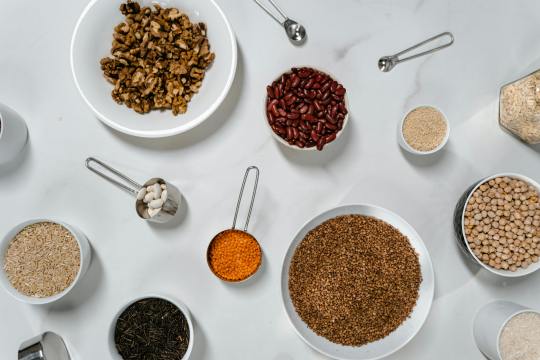Don't wanna be here? Send us removal request.
Text
Balancing Nutrition and Flavor: The Art of Chinese Meal Prep
In today’s fast-paced world, the importance of maintaining a balanced diet without compromising on flavor is more pressing than ever. Chinese cuisine, with its diverse ingredients and rich culinary history, offers a unique blend of both nutrition and taste. As individuals become more health-conscious, meal prepping has emerged as a practical solution for achieving this balance. This article will delve into the art of Chinese meal prep, exploring key ingredients, cooking methods, and meal ideas that prioritize both nutrition and flavor.
The Philosophy Behind Chinese Cuisine
Chinese cuisine is deeply rooted in the principles of balance and harmony. Traditional Chinese cooking emphasizes the integration of various flavors, colors, and textures, which plays a significant role in balancing nutrition. The concept of Yin and Yang illustrates this philosophy, promoting the idea that foods should complement each other to create a harmonious meal. With an emphasis on fresh vegetables, lean proteins, and whole grains, Chinese meals can be both satisfying and wholesome. In meal prep, applying this philosophy means carefully selecting ingredients that not only taste good but also contribute to overall health.
Key Ingredients for Nutritious Chinese Meal Prep
The foundation of any great meal prep is the selection of quality ingredients. In Chinese cooking, a variety of vegetables, legumes, and proteins can be utilized to achieve a healthful balance. Leafy greens like bok choy, Chinese broccoli, and spinach are excellent choices, packed with vitamins, minerals, and dietary fiber. Additionally, incorporating colorful vegetables such as bell peppers, carrots, and snow peas can enhance both flavor and nutrition. Lean proteins like chicken, fish, and tofu serve as excellent sources of amino acids, essential for muscle repair and growth.
Add Whole Grains for Extra Nutrition
Whole grains are a staple in many Chinese dishes, providing necessary carbohydrates and fiber for sustained energy. Brown rice, quinoa, and whole wheat noodles are great alternatives to their refined counterparts, offering a nutty flavor and added nutritional benefits. In meal prep, preparing grains in bulk can save time and serve as a base for various dishes. Moreover, pairing grains with vegetables and proteins ensures a balanced meal that maintains flavor without sacrificing nutrition.
Cooking Techniques for Flavorful and Healthy Meals
Cooking methods play an instrumental role in retaining the nutritional value of ingredients while enhancing flavor. Steaming, stir-frying, and braising are common techniques in Chinese cuisine that promote health. Steaming vegetables preserves their vitamins and minerals, while stir-frying at high heat with minimal oil can create a deliciously aromatic dish without excessive calories. Braising, on the other hand, allows flavors to meld together, making tough cuts of meat tender and full of flavor. These techniques not only provide taste but also ensure that meals remain vibrant and nutrient-rich.
Essential Seasonings and Herbs
No discussion about healthy Chinese food is complete without highlighting its vibrant seasonings and herbs that add depth to dishes. Ingredients like garlic, ginger, soy sauce, and sesame oil are staples that impart flavor without needing excessive salt or fat. Fresh herbs such as cilantro and scallions can also elevate a dish, offering a fresh burst of flavor. When meal prepping, consider marinades or sauces that incorporate these seasonings, allowing proteins and vegetables to soak up the flavors before cooking. This not only adds richness but also enhances the health benefits of the meals.
Easy Chinese Meal Prep Ideas
When it comes to meal prepping, the possibilities are endless. One simple yet nutritious option is a stir-fry that combines chicken or tofu with a rainbow of vegetables and served over brown rice. Another great idea is to create a vegetable-packed soup or broth, which can be made in large batches and frozen for quick lunches on busy days. Additionally, meal prep bowls filled with quinoa, roasted vegetables, and a protein of choice are both aesthetically pleasing and nutritious. Incorporating a variety of colors and textures will not only make the meals visually appealing, but will also ensure a well-rounded intake of different nutrients.
Portion Control and Balanced Meals
One of the crucial aspects of chinese meal prep is portion control, which is essential for maintaining a balanced diet. Dividing meals into appropriate serving sizes can help manage calorie intake while ensuring that all food groups are represented. Utilizing containers that promote balanced meals allows for easy meal distribution. For instance, a container with sections can hold a serving of protein, grains, and vegetables, ensuring that each meal is nutritionally complete. As a result, portion-controlled meals can prevent overeating and foster healthier eating habits.
Staying Motivated and Engaged
Meal prepping can sometimes become monotonous if the same recipes are repeated. To keep things exciting, it’s essential to explore new recipes and flavor combinations. This can be achieved by experimenting with different vegetables, proteins, and seasonings or trying new cooking methods. Additionally, involving family members or friends in meal prep can make the experience more enjoyable and fulfilling. Sharing ideas and recipes not only promotes creativity but also supports a collective effort toward healthy eating.
Conclusion
Balancing nutrition and flavor in Chinese meal prep is an art form that can elevate your culinary experience while prioritizing health. By selecting quality ingredients, employing wholesome cooking techniques, and incorporating vibrant flavors, meal prepping can be both enjoyable and nutritious. As you explore the rich world of Chinese cuisine, remember that the journey to a balanced diet should be one of discovery and creativity. The beauty of meal prep lies in its ability to transform simple ingredients into flavorful, healthful dishes that nourish both body and soul.

1 note
·
View note